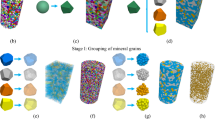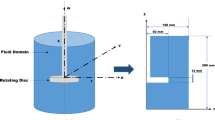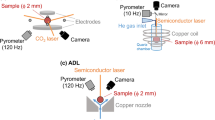Abstract
The simulation of the sand gravity casting process is complicated due to its multiscale and multiphysics nature. Although there are many commercial software options available, it remains extremely difficult to accurately predict the filling, solidification, and defects such as oxidation. Smoothed particle hydrodynamics (SPH) is a Lagrangian simulation approach that is particularly well-suited for modeling the gravity casting process. To validate the results of the filling, cooling, and solidification steps of the SPH method, it is interesting to introduce and design a 3D universal experimental test case of the gravity casting process that can be modeled in 2D. This universal test case is developed so that the hydrodynamic filling process can be analyzed in 2D while the cooling and solidification processes can be investigated in 1D. After comparing ProCAST, a commercial 3D mesh-based software, with the 2D SPH method, the results highlight the unique advantages of each approach in analyzing filling step and temperature evolution. The SPH simulations are better at capturing the essential aspects of fluid motion.



























Similar content being viewed by others
Data Availability
The data supporting the conclusion of this article are included within the article. Any queries regarding these data may be directed to the corresponding author
References
Bonollo F, Urban J, Bonatto B, Botter M (2005) Gravity and low pressure die casting of aluminium alloys: a technical and economical benchmark. ALLUMINIO E LEGHE 6:23–32
Guofa MI, Hengtao ZHAO, Kuangfei WANG, Zhian XU, Jitai NIU (2008) Simulation of mold filling and solidification on gravity casting of Al-Si alloy (A357). Mater Sci Forum 575-578:1204–1209
Sorte M (2017) Defects, root causes in casting process and their remedies: review. J Eng Res Appl 7(3):47–54
Viswanath A, Manu MV, Savithri S, Pillai UT (2017) Numerical simulation and experimental validation of free surface flows during low pressure casting process. J Mater Process Technol 244:320–330
Jakumeit J, Subasic E, Bu¨nck M (2014) Shape casting: 5th International Symposium. Wiley, San Diego
Zhang B, Cockcroft SL, Maijer DM, Zhu JD, Phillion AB (2005) Casting Defects in Low-Pressure Die-Cast Aluminum AlloyWheels. JOM 57:36–43
Ingle D, Narkhede BE (2018) A literature survey of methods to study and analyze the gating system design for its effect on casting quality. Mater Today: Proc 5:5421–5429
Ellingsen K, Coudert T, M'Hamdi M (2015) SPH based modelling of oxide and oxide film formation in gravity die castings, IOP Conf Ser: Mater Sci Eng 84(1)
Prakasha M, Cleary P, Grandfield J (2009) Modelling of metal flow and oxidation during furnace emptying using smoothed particle hydrodynamics. J Mater Process Technol 209:3396–3407
Minaie B, Stelson KA, Voller VR (1991) Analysis of flow patterns and solidification phenomena in the die casting process. J Eng Mater Technol 113:296–302
Liu S-g, Luo C-b, Li G-a, Gao W-l, Zheng L, Dai S-l (2018) Effect of pressurizing speed on filling behavior of gradual expansion structure in low pressure casting of ZL205A alloy. Res Dev 15(4):276–282
Im I-T, Kim W-S, Lee K-S (2001) A unified analysis of filling and solidification in casting with natural convection. Int J Heat Mass Transf 44:1507–1515
Kreziak G, Rigaut C, Santarini M (1993) Low pressure permanent mould process simulation of a thin wall aluminium casting, Materials Science & Engineering A: Structural Materials: Properties. Microstructure and Processing A173(1–2):255–259
Wenming Jiang, Zitian Fan (2014) Gating system optimization of low pressure casting A356 aluminum alloy intake manifoldbased on numerical simulation. China Foundry 11:119–124
Guofa Mi, Xiangyu Liu, Wang Kuangfei Fu, Hengzhi, (2009) Numerical simulation of low pressure die-casting aluminum wheel. China foundary 6(1):48–52
Ha J, Cleary P, Alguine V, Nguyen T (1999) Simulation of die filling in gravity die casting using sph and magmasoft. In: Second International Conference on CFD in the Minerals and Process Industries. CSIRO, Melbourne, Australia
Ye T, Pan D, Huang C, Liu M (2019) Smoothed particle hydrodynamics (SPH) for complex fluid flows: recent developments in methodology and applications. Phys Fluids 31(1)
Hu MY, Cai JJ, Li N, Yu HL, Zhang Y, Sun B, Sun WL (2018) Flow modeling in high-pressure die-casting processes using sph model. Int J Met 12:97–105
Niu X, Zhao J, Wang B (2019) Application of smooth particle hydrodynamics (SPH) method in gravity casting shrinkage cavity prediction. Comput Part Mech 6:803–810
Cleary P, Ha J, Sawley M (1999) Modelling industrial fluid flow application using SPH. Proceedings of the International Workshop on Bifurcation and Localisation
Wen-jiong CAO, Zhao-yao ZHOU, JIANG F-m (2015) Smoothed particle hydrodynamics modeling and simulation of foundry filling process. Trans Nonferrous Met Soc China 25:2321–2330
Chandra U (1990) Benchmark problems and testing of a finite element code for solidification in investment castings. Int J Numer Methods Eng 30:1301–1320
Sirrell B, Holliday M, Campbell J (1996) Benchmark testing the flow and solidification modeling of AI castings. JOM 48:20–23
Carozzani T, Gandin CA, Digonnet H et al (2013) Direct Simulation of a Solidification Benchmark Experiment. Metall Mater Trans A 44(2):873-887
Bublık O, Lobovsky L, Heidler V, Mandys T, Vimmr J (2021) Experimental validation of numerical simulation of free-surface flow within casting mold cavities. Eng Comput 38:4024–4046
Coniglio N, Sivarupan T, El Mansori M (2018) Investigation of process parameter effect on anisotropic properties of 3D printed sand molds. Int J Adv Manuf Technol 94:2175–2185
Zamani M (2017) Al-Si cast alloys -microstructure and mechanical properties at ambient and elevated temperature. Jönköping University, School of Engineering, Dissertation
Saada MB, El Mansori M (2021) Assessment of the effect of 3D printed sand mold thickness on solidification process of AlSi13 casting alloy. Int J Adv Manuf Technol 114:1753–1766
Prakash C, Voller VR (1987) A fixed grid numerical modelling methodology for convection-diffusion mushy region phase-change problems. Int J Heat Mass Transf 30(8):1709–1719
Monaghan JJ (1994) simulating free surface flows with sph. J Comput Phys 110(2):399–406
Krimi A, Rezoug M, Khelladi S, Nogueira X, Deligant M, Ramírez L (2018) Smoothed Particle Hydrodynamics: a consistent model for interfacial multiphase fluid flow simulations. J Comput Phys 358:53–87
Liu MB, Liu GR (2010) Smoothed particle hydrodynamics (SPH): an overview and recent developments. Arch Comput Methods Eng 17:25–76
Cleary PW, Ha J, Sawley ML (2001) Modelling industrial fluid flow applications using SPH. Bifurcation and Localisation Theory in Geomechanics. CRC Press, p 8
Cleary PW, Ha J, Prakash M, Nguyen T (2006) 3D SPH flow predictions and validation for high pressure die casting of automotive components. Appl Math Model 30:1406–1427
Sun PN, Colagrossi A, Marrone S, Zhanga AM (2017) The δplus-SPH model: simple procedures for a further improvement of the SPH scheme. Comput Methods Appl Mech Eng 315:25–49
Antuono M, Colagrossi A, Marrone S (2012) Numerical diffusive terms in weakly-compressible SPH schemes. Comput Phys Comm 183:2570–2580
Meringolo DD, Marrone S, Colagrossi A, Liua Y (2019) A dynamic δ-SPH model: how to get rid of diffusive parameter tuning. Comput Fluids 179:334–355
Meringolo DD, Liu Y, Wang X-Y, Colagrossi A (2018) Energy balance during generation, propagation and absorption of gravity waves through the δ-LES-SPH model. Coast Eng 140:355–370
Antuonoa M, Colagrossi A, Marronea S (2012) Numerical diffusive terms in weakly-compressible SPH schemes. Comput Phys Commun 183:2570–2580
Monaghan JJ, Gingold RA (1983) Shock simulation by the particle method SPH. J Comput Phys 52:374–389
Brent A, Voller V, Reid K (1988) Enthalpy-porosity technique for modeling convection-diffusion phase change: application to the melting of a pure metal. Numer Heat Transf A: Appl 13(3):297–318
Mackenzie JA, Robertson ML (2000) The numerical solution of one-dimensional phase change problems using an adaptive moving mesh method. J Comput Phys 161:537–557
Fachinotti VD, Cardona A, Huespe AE (1999) A fast convergent and accurate temperature model for phase-change heat conduction. Int J Numer Meth Eng 44:1863–1884
J. Crank, “Free and moving boundary problems,,” 1984.
Meyer GH (1973) Multidimensional stefan problems. SIAM J Numer Anal 10(3):522–538
Egolf W, Manz H (1994) Theory and modeling of phase change materials with and without mushy regions. Int J Heat Mass Transf 37(18):2917–2924
Schwaiger HF (2008) An implicit corrected SPH formulation for thermal diffusion with linear free surface boundary conditions. Int J Numer Methods Eng 75:647–671
Adami S, Hu X, Adams N (2012) A generalized wall boundary condition for smoothed particle hydrodynamics. J Comput Phys 231(21):7057–7075
Lan P, Zhang J (2014) Study on the mechanical behaviors of grey iron mould by simulation and. Mater Des 53:822–829
Su-Ling L, Xiao F-R, Zhang S-J, Mao Y-W, Liao B (2014) Simulation study on the centrifugal casting wet-type cylinder liner based on ProCAST. Appl Therm Eng 73:512–521
Hua W, Haiming S, Haifeng L, Zhenjia X (2012) Numerical simulation of flow field and temperature field on aluminium alloy engine cylinder in casting process. Mater Sci Forum 704-705:50–57
Acknowledgements
The authors acknowledge the contribution of colleagues. Thanks are due to J. Bourgeois and J. Nègre of the Arts et Metiers ParisTech for their technical support.
Funding
Institut Carnot ARTS
Author information
Authors and Affiliations
Contributions
Mohammad Zarbini Seydani: numerical simulation, investigation, data curation, methodology, writing—original draft
Abdelkader Krimi: numerical simulation, methodology, conceptualization
Marie Bedel: experimental work, investigation, methodology, conceptualization
Sofiane Khelladi: numerical simulation, methodology, conceptualization
Mohamed El Mansori: supervision, conceptualization, methodology
Corresponding author
Ethics declarations
Ethical approval
Not applicable
Consent to participate
All the authors agree to participate in this research study.
Consent for publication
The authors consent to have the data published.
Competing interests
The authors declare no competing interests.
Additional information
Publisher’s note
Springer Nature remains neutral with regard to jurisdictional claims in published maps and institutional affiliations.
Rights and permissions
Springer Nature or its licensor (e.g. a society or other partner) holds exclusive rights to this article under a publishing agreement with the author(s) or other rightsholder(s); author self-archiving of the accepted manuscript version of this article is solely governed by the terms of such publishing agreement and applicable law.
About this article
Cite this article
Zarbini Seydani, M., Krimi, A., Bedel, M. et al. A 2D filling and solidification benchmark test: validating smoothed particle hydrodynamics (SPH) simulations for sand gravity casting. Int J Adv Manuf Technol 128, 801–821 (2023). https://doi.org/10.1007/s00170-023-11892-2
Received:
Accepted:
Published:
Issue Date:
DOI: https://doi.org/10.1007/s00170-023-11892-2




